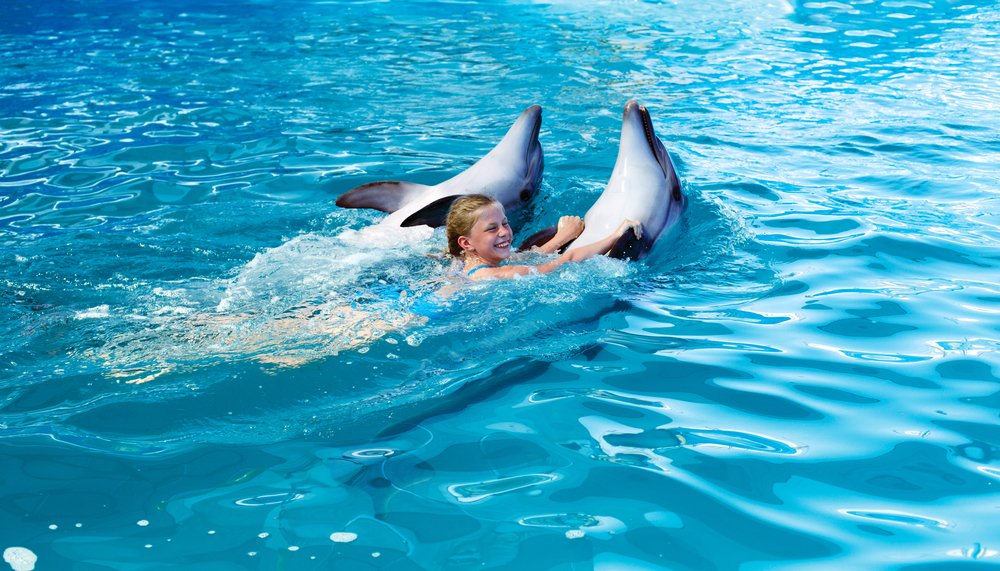Dolphin therapy in Türkiye
Dolphin therapy is a type of physical therapy that targets people with mental or physical disorders and is beneficial for children with autism, cerebral palsy, attention deficit hyperactivity disorder, physical disabilities and other psychological disorders. And during human life and since the beginning of creation, humans and animals harmonized at various levels, and animals were a help to man in his escape from many disasters. And for more than 12,000 years, humans and animals have been in therapeutic relationships, and perhaps the most famous example of this is the dog and the close relationship that binds it with humans. Dolphins as a therapeutic agent with individuals with different disabilities, especially children, and this led to the development of a treatment known as Dolphin Assisted Therapy (DAT) as it is an attractive form of therapy because dolphins are beautiful and lovable animals.

Dolphin therapy
There are many different forms of dolphin-assisted therapy ranging from simply looking at or grooming a dolphin, and touching them, to entering the water and swimming with them. But in general, the treatment includes swimming and having fun with the dolphins for several sessions while working on specific tasks. Such as coordination between the hand and the eye and the rest of the body parts such as the hands and feet, in addition to stimulating the different verbal response with the dolphins. In other words, the primary purpose of the dolphin therapy program in Türkiye is to further improve the targeted behaviors based on the individual child’s program by using dolphins and the close relationship they form with the child to complement other, more traditional therapies. The length of the sessions and the number of times they are repeated varies according to the programme. Some sessions last for a week, two weeks, or a month, and each session lasts 10-30 minutes.
An example of an example of dolphin therapy:
The child passes on the raised platform in front of the pool accompanied by the attendant and sits on the edge of the platform, which is 2-3 inches high. While the trainer is in the water, he manipulates the dolphin’s movement, then the child can touch the dolphins, play with them, or give simple commands through hand signals to get to know the dolphins and get to know them. This stage is considered preliminary, and once completed, a series of treatment sessions begins. During these therapy sessions, children are allowed to play with the dolphins for a short time either from the dock or to swim with them in the water. During playtime, children can touch or kiss the dolphin, dance in a circle with them, or ride them by holding on to the dorsal fin.
Among the most important cases in which dolphin therapy is recommended:
- Cerebral palsy.
- Autism in children.
- Brain dysfunction.
- Down’s syndrome.
- Speech delay.
- behavioral complications.
- Psychological and verbal stress.
studies
Nathanson reported that the two-week dolphin therapy program significantly increases a child’s language, speech, and complex bodily movement abilities. and fine motor performance among children with various disabilities compared to conventional physiotherapy or speech therapy programmes. Nathanson and his colleagues compared dolphin therapy with traditional therapies in a study in which each child (with multiple disabilities) received six months of conventional therapy before undergoing dolphin therapy. Then they underwent 16 or 17 sessions of dolphin therapy. They concluded that children with severe disabilities had increased motor skills, attention span, and improved language use and pronunciation.
Another study was conducted in 1998 to examine the long-term effects on former participants in dolphin treatments, and 137 questionnaires were sent to evaluate the long-term effects to them, and then the data was collected and analyzed. The results showed that the former participants in these treatments benefited more than traditional treatments by (52%) as shown It showed beneficial long-term effects for about 95% of children treated.
A study conducted by Antonioli and Revelli evaluated the effects of swimming with dolphins on levels of depression and anxiety in individual children with mild to moderate depression. Where the participants were asked to stop taking any medications (antidepressants) or receive psychological treatment four weeks before the start of the study, the Hamilton scale, the Beck depression inventory, and the Zung scale were adopted in assessing anxiety as behavioral and psychological measures. At the end of the treatment, the results showed a significant improvement in the degrees of depression and anxiety. .
Dolphin sound
The dolphin has sound frequencies and a distinctive vibrational rhythm that affects the emotional aspect of the child. It also has a natural sonar device, such as the sonar found in ships and planes, as it emits high-frequency sound waves to locate objects and to communicate with other animals. These frequencies are so intense that they create gaps or openings in liquid particles . The body or its soft tissues, and these researchers believe that sound frequencies have a profound effect on the human brain by influencing brainwave activity.
Dolphin therapy results:
From the foregoing, we see that dolphin therapy has many benefits, the most important of which is
- Develop and improve the ability to communicate, especially children with autism spectrum disorder.
- Increasing attention and concentration in children with poor attention and focus.
- High self-confidence.
- Development of fine and complex motor skills.
- An increase in the ability to motor coordination.
- Development in eye contact and in senses such as touch.
- Positive changes in the emotional aspects of the child.
- improvement in patients with cerebral palsy.
Dolphin therapy in Türkiye:
The medical staff of surgical teams, doctors and consultants in REHABTÜRK can provide the best treatment options and free consultations – by striving to keep abreast of the latest medical technologies and methods.
